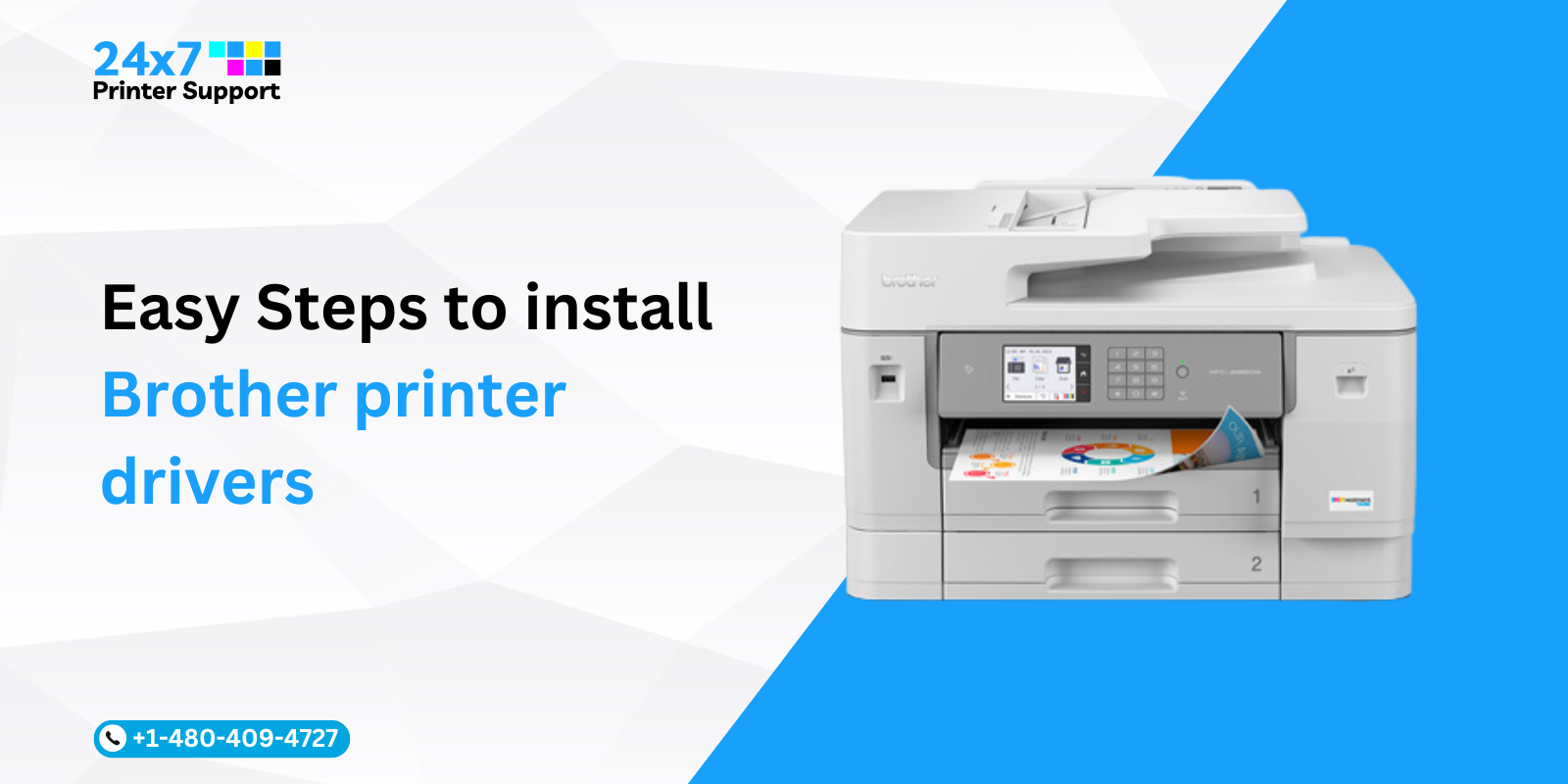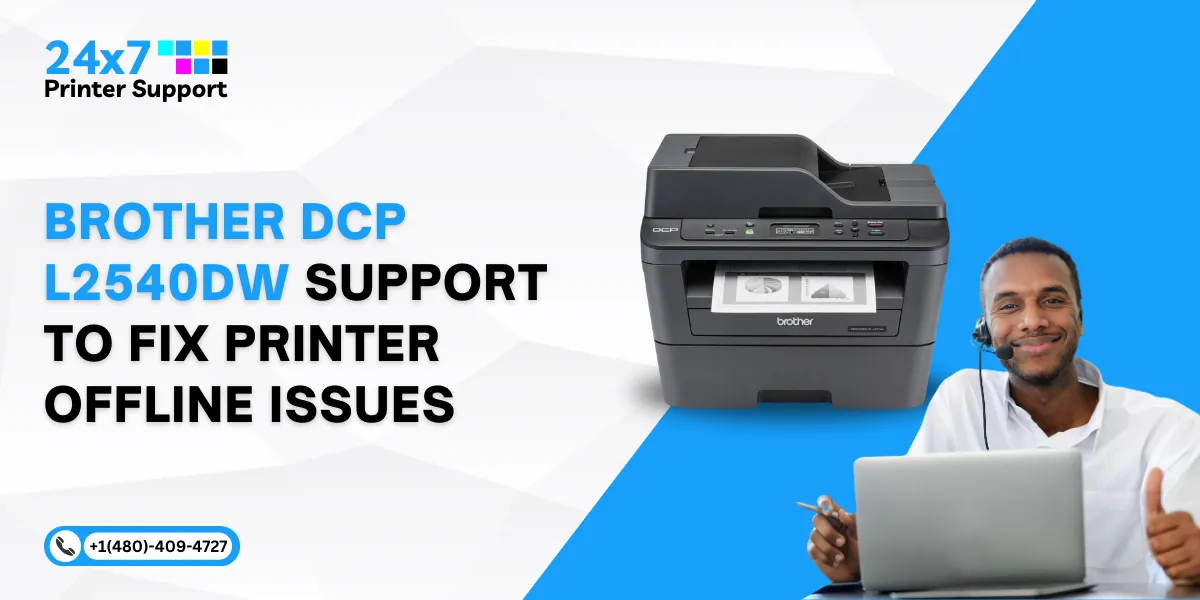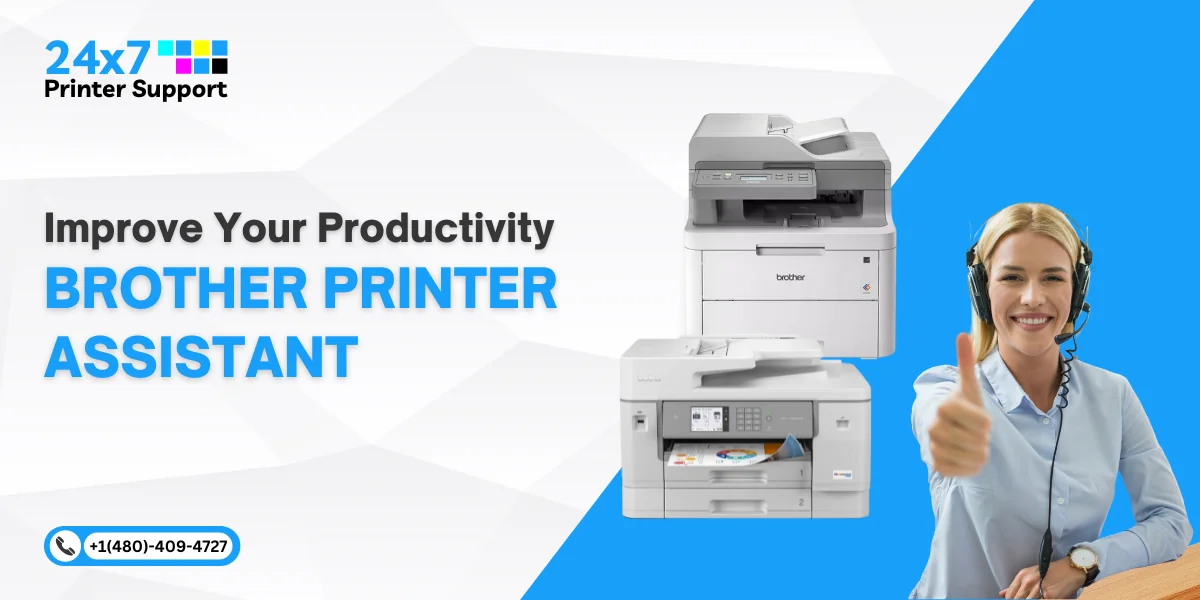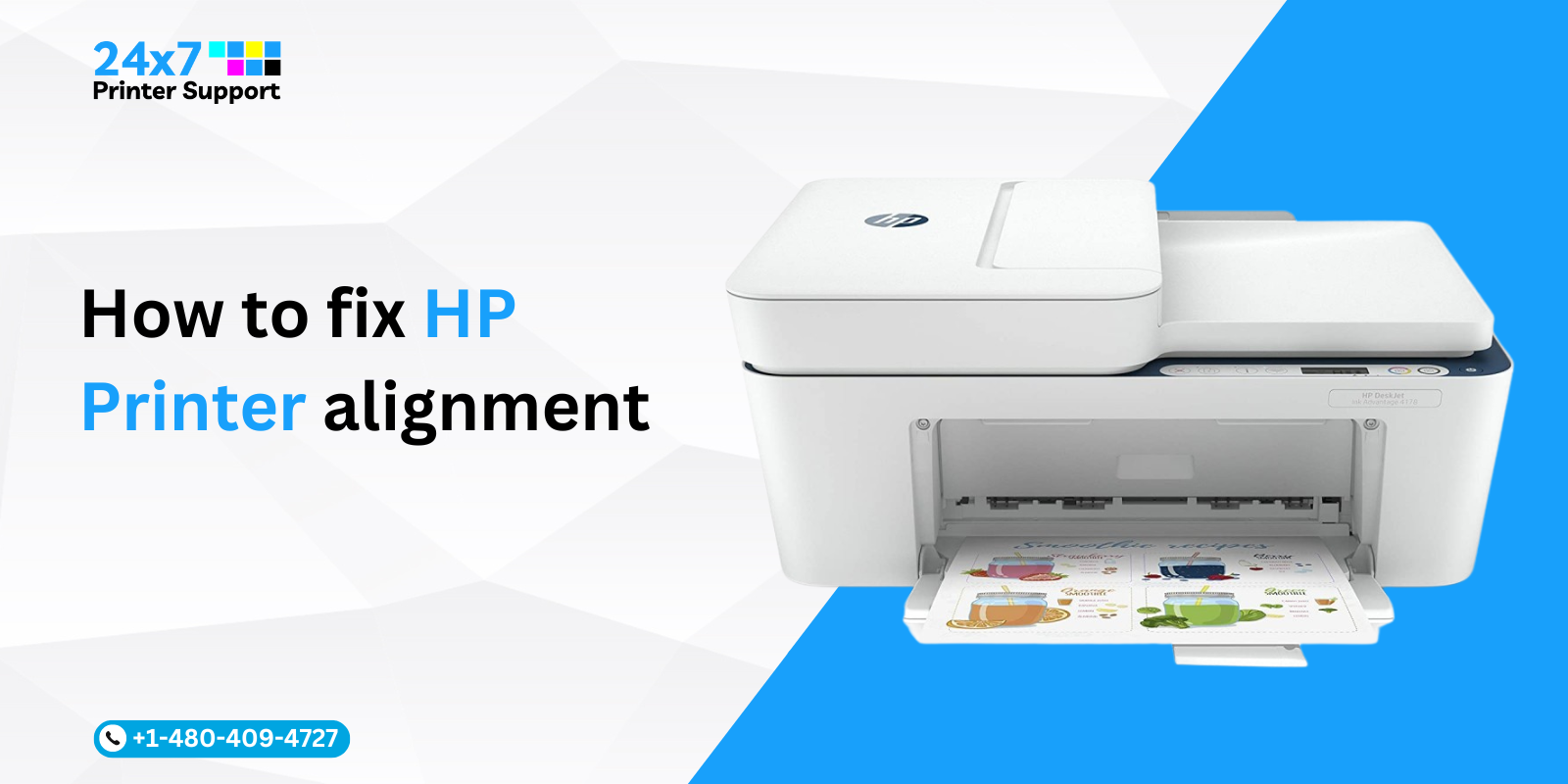Brother is a well-known brand in the printing business and offers high-end home and office printers.
Brother is known for its high-quality laser printers and Inkjet Printer models.
Some common Brother printer problems may occur while printing. In case, you can’t get done with the brother printer setup or if the hardware or software is malfunctioning, you can usually finish repairing your Brother printer by the end of this article. If you are not tech-savvy and do it yourself, you can count on the Brother printer support team.
Common Brother printer issues and how to resolve them
Take a look at the common brother printer problems:
Preventing Paper Jams
With the right approach, you can deal with paper jams effectively. This guide will show you how to handle paper jams. But to be perfect at handling it, contact the brother printer customer service team.
Step 1
Turn off: The first thing is to turn off the printer. Prevent the printer from becoming a jam before using it to remove it and prevent any accidents.
Step 2:
Follow the instructions: Follow the instructions of the printer manufacturer to open the printer. You should take your time to find out where the paper jammed. You can find it in the output tray, paper feed area, or other parts of the printer that are accessible.
Step 3:
Remove the jammed paper: This requires patience and precision. Grab the paper gently with both hands and slowly and steadily pull it out. Follow the direction the paper is going. To avoid complicating the problem, do not tear the paper.
Step 4:
Check the Printer for Remaining Paper: Even after you remove the main piece of paper that is jammed, there may be small pieces of paper still lodged inside the printer. Use a flashlight and thoroughly check the inside of your printer to find any remaining scraps. It is important to remove them to prevent future jams.
Step 5:
Reload the Paper Tray. If you removed the tray to get to the jam, make sure it’s reinserted correctly. Aligning the paper correctly within the tray will help to prevent future jams.
Step 6:
Paper quality matters: Use only the paper type and grade recommended by Brother product support to match your printer model. Paper of low grade or incorrect thickness can cause jams.
Step 7:
Align and Fan Paper: Before loading the paper into the tray, fan the stack out to separate the sheets. This will prevent them from sticking. Aligning the edges of your paper stack will ensure that it is flat and straight in the tray.
Step 8:
Adjust the Paper Guides: The paper guides should be adjusted so that they fit snugly on the paper, but not too tightly. To prevent misfeeds, ensure they are correctly aligned with the paper size.
Step 9:
Do not overload the tray: Overfilling the tray can cause jams due to increased pressure and improper feeding.
Step 10:
Preventive maintenance is essential: Make sure to regularly clean your Brother Printer, such as the paper-feeding rollers, and remove debris and dust from the inside. For specific model maintenance, kindly check your brother laser printer manual or access Support Resources.
Read More: Maintenance Tips from Brother Printer Experts
Print Quality Issues and Solutions
To solve print quality issues, you need to take a systematic approach. This guide will help you resolve various print quality problems:
Faded prints
- Check your ink and toner levels: Make sure you have enough ink or toner in the cartridges. Replace or refill cartridges if necessary.
- Print settings can be adjusted. To improve the clarity of your print, increase the density or print quality settings.
- Regularly cleaning printheads and drums of toner is recommended. Over time, they may become clogged by debris or dried toner/ink. Prints will fade. Clean them according to the manufacturer’s instructions.
Prints that are blurry or smudged:
- The right paper is essential for your printer. The wrong paper may cause blurriness and smudging.
- Make sure your settings are compatible with what you’re printing.
- Toner drums and printheads should be cleaned. Dirt, smudges, or blurriness on the printheads can cause dirt to build up. Clean them to restore print quality.
Uneven or patchy print:
- It is essential to clean printheads and drums. It is important to remove any debris or buildup on the printheads or toner rollers that may be causing an uneven printout.
- To ensure accurate color reproduction, calibrate your printer.
- Check the printer for signs that it has been damaged or worn out. If necessary, replace damaged parts.
Ghosting or double imaging:
- Verify settings. Make sure that you have selected the right paper type and settings in your printer’s software. The wrong settings can cause double or ghost images.
- Replace or clean the imaging drum or belt. Ghosting may occur due to an old or dirty imaging or transfer drum. To resolve this issue, replace or clean the components.
- Stability: Make sure your printer is placed on a flat surface. Vibrations can cause ghosting.
Paper Jams:
- To safely remove jammed papers, follow the instructions in the printer manual.
- Check tray alignment. Make sure the tray is aligned correctly and that it can accommodate the size of the paper.
- Verify the correct paper specifications. Check that the paper used is in accordance with the manufacturer’s specifications.
- Cleaning feed rollers is important to avoid paper jams. Regularly clean them to ensure smooth feeding of paper.
Streaks and Lines on Prints
- Cleaning printheads and toner drums is important. Remove any excess toner or debris that could be causing streaks on your prints.
- Examine the printer for wear and damage. Inspect print heads as well as toner drums. Replace damaged parts if necessary.
- Self-cleaning cycle: Many printers come with self-cleaning cycles and maintenance cycles. These can be used to enhance print quality. To run these cycles, follow the instructions from the manufacturer.
- Printheads that are not aligned correctly can produce streaks and lines. Use the software or menus to align them.
Color Inconsistencies:
- Verify color settings. Check to see if your printer software is set up correctly for the desired output color.
- Calibrate your printer. To ensure that color reproduction on all prints is consistent, calibrate your printer.
- Only use cartridges and toner of high quality. They may cause color variations. Genuine or high-quality cartridges are compatible with your printer.
- To maintain color consistency, replace empty cartridges. To maintain color consistency, replace them with new cartridges.
Connectivity problems
Solving common connectivity issues is as simple as troubleshooting network settings and connections. This guide will show you how to fix any printer connectivity problems.
Printer not detected on the network:
- Check the network connection. Verify that the printer has been connected properly to the network using Ethernet or Wi-Fi. Verify that the network cables and WiFi connections are stable.
- Restart the devices: Turn off your printer, computer, and router. Wait a few moments, and then turn them back on in the right order.
- Verify IP Address: Print the network configuration page to verify its IP address. Verify that the IP addresses match the gateway and subnet settings.
- Configure firewall settings. Temporarily disable antivirus or firewall software on your PC and adjust settings if needed to allow printer communications.
- Reinstall printer driver: Uninstall any existing drivers on your computer, and then reinstall them from the Brother Website.
Brother printer not printing wirelessly
- Verify Wi-Fi connection: Confirm the printer is connected to the same Wi-Fi network as the computer. Check the Wi-Fi signal and move it if needed.
- Restart the devices: Turn off your printer, computer, and router. Wait a few moments, and then turn them back on in the right order.
- Connect to WiFi Network: To reconnect to the WiFi, go to printer settings. Enter the Wi-Fi password and name if prompted.
- Verify printer compatibility and computer connectivity: In the Control Panel or System Preferences, check printer compatibility and computer compatibility. If necessary, remove and add the printer once more.
- Install the latest firmware version by checking the Brother website for updates. Restart the printer to try wireless printing again.
Mobile Device Cannot connect:
- Verify mobile device connectivity. Ensure the mobile device is linked to the same WiFi network as your printer. Check the Wi-Fi strength of your mobile device.
- Download the Brother Printer App: Install the Brother Printer app on your mobile phone. Follow the setup wizard to connect and detect the printer.
- Verify printer sharing: Check printer sharing settings to ensure mobile devices can connect. If necessary, adjust settings according to the manual of your printer.
- Restart the devices: Turn off your mobile, router, and printer. Wait a few moments, and then turn them back on in the right order.
- Consult the manual of your printer or Brother printer helpline resources to find out how can you troubleshoot the connection.
Problems with Toner or Ink
For ink or laser brother printer problems and solutions, you need to use the right maintenance techniques and troubleshooting methods. This guide will help you to resolve common ink and toner problems.
Low toner or ink warning
- Buy and replace cartridges. Purchase new ink cartridges or toner cartridges at a trusted source. Replace the cartridges according to the instructions provided by the manufacturer.
Poor print quality:
- Check the levels. Make sure that you have enough ink or toner for printing. If the cartridges are empty or low, replace them.
- Cleanse the printer: Many printers feature cleaning cycles designed to unclog toner or nozzle lines and improve print quality, so run these cycles according to the manufacturer’s instructions for optimal results.
- If the print quality does not improve after several cleaning cycles, cartridges that do not correspond with your printer should be switched out for ones compatible with it. Without compatibility between cartridges and printers, printing errors could occur as the printer cannot recognize these cartridges as legitimate options.
- Verify Cartridge Type: Make sure you are using the appropriate cartridge. Consult your printer’s user manual for information on which ones are compatible.
- Remove protective covers. Check the cartridge for protective covers or seals that obstruct sensors or contacts. Remove them before installing the cartridge.
- Cleaning contacts: Clean the contacts inside and on the cartridge with a lightly damped lint-free cloth. Be sure to dry the contacts completely before reinstalling any cartridge.
- Restart your printer: Turn it off, wait for a few seconds, and then turn the printer back on. The printer may recognize the cartridge after rebooting.
Toner dries quickly:
- To save on toner, choose the economy or draft settings of the printer.
- Calibrate your printer. You can calibrate the printer to ensure that you are using optimal toner and that toner is properly fused to paper.
- Toner cartridges must be stored away from direct sunlight or heat. Toner cartridges should not be exposed to extreme temperatures or humidity.
Toner smear:
- Install the toner cartridges correctly. Make sure you do it by following the manufacturer’s instructions.
- Replace your old toner cartridge. If you see toner streaks, replace it with a new toner compatible with your printer.
- Check for signs of wear or damage. Examine the fuser for signs of damage or wear. Replace the fuser if necessary to resolve toner smear issues.
Scanner and faxing problems
You will need to troubleshoot hardware and software to resolve scanner and faxing issues. This guide will help you resolve scanning and faxing problems.
Scanner Not Working:
- Verify connections. Verify that the scanner is properly connected to the computer. Verify that the scanner is powered and the cables are connected properly.
- Update drivers: Download drivers from the manufacturer or installation disc.
- It is essential to clean the glass of the scanner. Dust, fingerprints, and other debris can affect scan quality. The best way to clean the glass is with glass cleaner and a non-lint, soft cloth.
- Power cycle printer – Disconnect the power cable and turn off your printer, scanner, and printer. Wait for a few seconds before connecting the devices and turning them on.
Poor scan quality:
- A dirty or smudged scanner glass can result in poor scan quality. Clean the glass with a glass cleaner on a lint-free cloth.
- To improve the scan quality, adjust the scan settings. Modify settings like resolution, color depth, and file format. Try different settings until you find the best configuration.
- Contact support: For further help and troubleshooting, contact the manufacturer’s support service if scan quality problems persist.
Faxing doesn’t work:
- Check the phone line. Make sure that the phone is connected properly to the fax and that you have a dial tone. Make a voice call to test the phone line.
- Verify settings. Check settings like dialing mode and transmission speed. Verify that your fax machine settings and network are correct.
- Power cycle printer: Disconnect the power cord and turn off the printer (and fax) before reconnecting. Wait a few moments before connecting and turning on the devices.
- Contact the manufacturer: If you continue to have problems with your fax machine, you can contact their printer support service for more information and troubleshooting specific to your model.
Contact Brother Printer support
Brother’s warranty and customer service are vital to the longevity and smooth operation of the printer. We will explain how to use these resources effectively.
Check the Warranty Status
- Check if the printer is covered under warranty. Before contacting support, you should check if the printer is still covered. Visit the official Brother website or contact their customer service team to find out. This process is easier if you provide the serial number of your printer or its purchase date.
- Verify your warranty online: Many manufacturers provide online tools that allow you to enter the details of your printer and instantly check its status.
- Personal assistance: If you do not have access to online verification or prefer direct communication with Brother, you can contact their customer service via email, phone, or live chat.
Find the problem:
- Before contacting support, identify the problem. Document any error message, strange sounds, or visual symptoms to give detailed information to support.
- Diagnostic tools: Some printers have diagnostic tools built-in or error codes that can be used to pinpoint the cause of a problem.
- Test prints: Conducting test prints can reveal issues relating to print quality and paper feed as well as other performance indicators.
Contact Brother Support:
- Contact Brother customer service as soon as you identify the problem. Choose your preferred method of communication–phone, email, or live chat–and provide relevant details about the problem you’re experiencing.
- Prepare yourself. Gather the information you need before calling customer service. This includes the model number of your printer, the serial number, and a brief description of the issue. You can streamline troubleshooting by providing this information. This will give the support team additional time.
Service Request
- Send a service order if needed: If remote troubleshooting cannot resolve the problem, Brother customer support will send a request for a repair or replacement. Follow the instructions of the support team. Provide any information they request.
- If you need to ship your printer for service, the support team can provide detailed instructions regarding packaging and shipping. Please follow these instructions to ensure that your printer is transported safely.
Prepare for servicing:
- Follow the instructions to prepare your printer. If your printer needs servicing, you will need to follow the instructions from Brother’s Customer Support team. It is necessary to pack the printer securely, remove consumables such as ink and toner cartridges, or provide documentation like proof of purchase.
- Protect sensitive components. To avoid further damage, you should secure all movable components, delicate components, or removable accessories within the printer. Use the packaging materials supplied by Brother, or other suitable alternatives, to cushion and protect your printer from shock.
Service or Replacement
- Brother will replace or repair your printer. Once the printer has been received by Brother for service, the technicians will diagnose the problem and fix it according to the terms of the warranty. Brother will offer to replace the printer if the printer is beyond economic repair or cannot be repaired.
- Brother strives to communicate with its customers transparently throughout the entire servicing process. You can receive an update on the status and timelines of your service request.
Conclusion
Brother’s commitment to providing comprehensive customer support and warranty service ensures users can resolve printer issues quickly and effectively. You can easily navigate the brother label maker troubleshooting process by following these comprehensive guidelines and using Brother’s resources. Brother’s support team will assist you with printer repair, replacement, or troubleshooting any Brother printer issues. They ensure optimal performance and customer satisfaction. Keep your printer documentation, such as warranty information, easily accessible so you can refer to it quickly when necessary.
Call Us For Instant Solutions
Don’t Let Printer Problems Hold You Back!
Author – Franklin
Franklin is a seasoned content writer with 10 years experience in technology and business content across multiple formats. He leverages his skills in crafting curated content on the printer issues and solution. In his personal time, He enjoys reading article and being up-to-date on trends in technology and business ecosystem.






